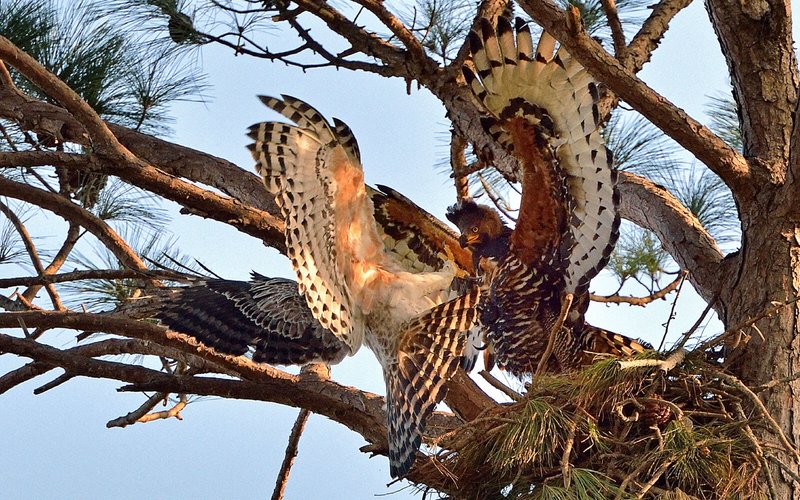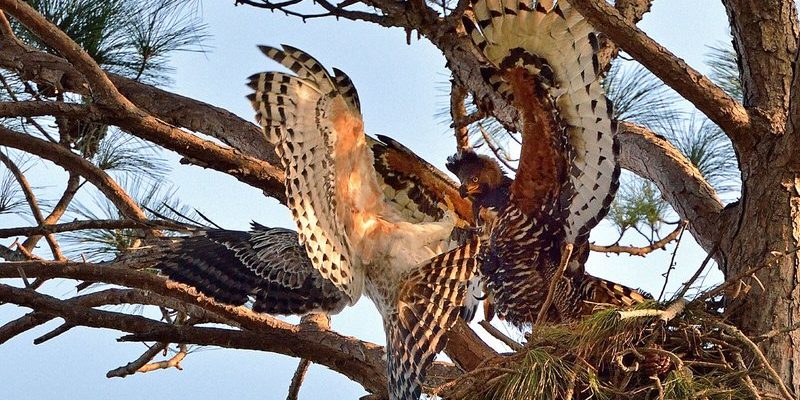
Crowned Eagles are not just any birds; they’re the top predators in their environment, which makes their breeding and nesting behaviors particularly interesting. Much like how we humans set up a cozy home for our families, these eagles meticulously select their nesting sites and take great care in raising their young. So, grab your favorite beverage, and let’s dive into the captivating world of the *Crowned Eagle’s* nesting habits and lifecycle.
Understanding Crowned Eagles
Crowned Eagles, scientifically known as *Stephanoaetus coronatus*, are unique among birds of prey. They primarily inhabit the dense *tropical and subtropical forests* of Africa, where they find both cover and the necessary resources for hunting. Their wingspan can reach up to 2.2 meters, making them one of the largest eagles on the continent. But it’s not just their size that stands out; it’s their distinct dark brown feathers contrasted with a striking white crown that gives them their name.
These eagles are apex predators, meaning they sit at the top of the food chain. They mainly hunt small to medium-sized mammals and birds, including monkeys and small deer. The strength and sharpness of their talons make them highly efficient hunters. Understanding their nesting habits can help us appreciate how they contribute to the ecosystem as they keep populations of prey in check.
Nesting Sites: Where the Magic Happens
So, where do Crowned Eagles decide to set up their nests? Typically, they prefer tall trees within their forest habitats. These trees provide not only a good vantage point for hunting but also protection from ground predators. Think of it like choosing the best spot for a treehouse—it’s got to be high enough to feel safe yet accessible enough for the parents to come and go.
Crowned Eagles usually build their nests from large sticks and reinforce them with soft materials like leaves and moss. This construction is crucial as it needs to withstand the elements and the weight of their young. You might wonder how they choose the right tree. These eagles look for trees that are sturdy and have plenty of branches, ensuring a comfortable and secure home for their chicks.
Breeding Season: A Time for Love
The breeding season for Crowned Eagles generally spans from April to October, depending on their specific location. During this time, male and female pairs engage in elaborate courtship displays. They soar high in the sky, performing aerial acrobatics that are not just beautiful but serve to strengthen their bond. It’s like a dance in the air, signifying their commitment to one another.
Once the pair is established, they will typically mate for life, returning to the same nest year after year. This fidelity ensures that they can raise their young successfully in a familiar environment. After mating, the female will lay one to three eggs, usually just two, which she will incubate for about 45 to 50 days. The male assists by bringing food during this critical time, showcasing their teamwork.
The Nesting Cycle: Hatching and Raising Young
Hatching is a tense time for Crowned Eagles. When the eggs finally crack, the chicks are altricial, meaning they’re born helpless and dependent on their parents. They rely on mom and dad for food and protection during their early weeks. Here’s where it gets interesting: the adults will often hunt larger prey and bring it back to the nest. This not only provides nourishment for the chicks but also strengthens them for their eventual leap into independence.
Over the next several weeks, the chicks grow rapidly. They’ll start to develop feathers and begin to practice their wing flaps. It’s almost like a “coming of age” moment in their lives. They need to be strong and ready, as being a bird of prey comes with its own set of challenges. Parents will teach their young how to hunt, which means that they’ll be flying and swooping through the trees, honing their skills before they head out on their own.
Life Beyond the Nest: Independence
Once the chicks reach about 10 to 12 weeks of age, they’ll fledge, or leave the nest. But that doesn’t mean they’re completely on their own just yet. The young eagles will remain dependent on their parents for food and guidance for several more months. This extended family dynamic is crucial, as the parents continue to teach their young the ins and outs of survival.
Each fledgling will eventually develop its own territory. In some cases, siblings may still stick together for a while, helping each other navigate their new world. This independence period is a critical phase in their lifecycle, as they learn how to hunt and establish their place in the ecosystem. It’s a mix of excitement and trepidation, much like a young adult moving out for the first time.
Challenges and Conservation
Crowned Eagles face various challenges in the wild, including habitat loss due to deforestation and hunting. As human activities encroach on their habitats, these majestic birds struggle to find suitable nesting sites and food sources. Conservation efforts are crucial to ensuring their survival. Programs focused on habitat preservation, education, and community involvement can make a significant difference in protecting these incredible birds.
Organizations often work closely with local communities to promote sustainable practices. By giving people alternatives to harmful activities, such as those impacting the eagle’s habitat, we can help foster a coexistence that allows these birds to thrive in their natural environments.
Understanding the Crowned Eagle’s nesting habits and lifecycle not only helps us appreciate their beauty but also highlights the importance of conservation. As we marvel at these incredible birds, it’s vital to remember the role each of us plays in protecting their habitats. By ensuring they continue to soar in the skies above our forests, we preserve a piece of nature’s drama that enriches our world.
Whether you’re a birdwatcher, a nature lover, or simply curious, the Crowned Eagle offers a glimpse into the complex and fascinating life of one of nature’s most formidable hunters. So next time you find yourself in the heart of their habitat, take a moment to listen for their distinctive calls and look up high—who knows, you might just catch a glimpse of these royal birds in their elegant flight.

